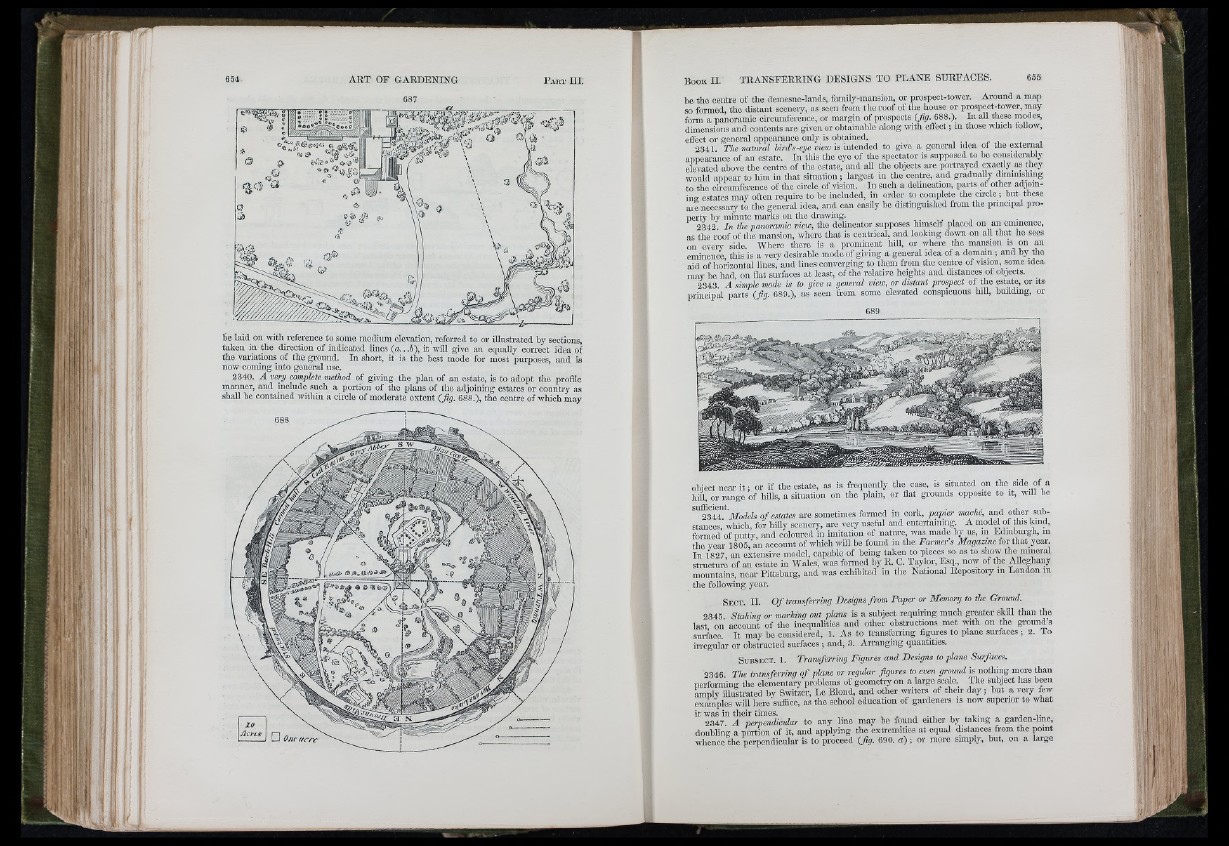
taken in the direction of indicated lines (a ...b ), it will give an equally correct idea of
the variations of the gi-ound. In short, it is the best laode for most purposes, and ia
now coming into general use.
2340. A very complete method of giving the plan of an estate, is to adopt the profile
manner, and include such a portion of the plans of the adjoining estates or country as
shall be contained within a circle of moderate extent ( fig . 688.), the centre of which may
T R A N S F E R R IN G D E S IG N S TO P L A N E SU R FA C E S .
be the centre of the demcsnc-lands, family-mansion, or prospect-tower. Around a map
so formed, the distant scenery, as seen from the roof of the house or prospect-tower, may
foim a panoramic circumference, or margin of prospects (fig . 688.). In all these modes,
dimensions and contents ai-e given or obtainable along with effect •, in those which follow,
effect or general appearance only is obtained.
2341 T he n a tu ra l b ird ’s-eye view is intended to give a general idea of the external
appearance of an estate. In this tlie eye of the spectator is supposed to be considerably
elevated above the centre of the estate, and all the objects are portrayed exactly as they
would appear to him in that situation ; lai-gest iu the centre, and gradually diminishing
to the circumference of tho circle of vision. In such a delineation, parts of other adjoincstates
may often require to be included, in order to complete the circle; but these
necessary to the general idea, and can easily be distinguished from the prmcipal property
by minute marks on the drawing.
2342 I n the panoram ic view , the delineator supposes himself placed on an eminence,
as the roof of the mansion, where that is centrical, and looking down on all that he sees
on every side. Where there is a prominent hill, or where the mansion is on an
eminence, tliis is a very desirable mode of giving a general idea of a domain; and by the
aid of horizontal lines, and lines converging to them from the centre of vision, some idea
may be had, on flat sui-faces at least, of the relative heights and distances of objects.
2343 A simple mode is to give a general view , o r d istan t prospect of the estate, or its
principal parts (fig . 689.), as seen from some elevated conspicuous hiU, building, or
obiect near it ; or if the estate, as is frequently the case, is situated on the side rf a
hill, or range of lulls, a situation on the plain, or flat grounds opposite to it, will be
M odels o f estates are sometimes formed in cork, p a p ie r maché, and other substances,'
which, for hilly sceneiy, are very useful and entertaining A modd of this kind,
foi-med of putty, and coloured in imitation of nature, was made by us, m Edinburgh, m
the year 1806 an account of which will be found in the F a rm e r’s M ag a zin e for that year.
In 1827 an extensive model, capable of being taken to pieces so as to show the mineral
struotui-o of an estate in Wales, was formed hy E. C. Taylor, Esq., now of the Alleghany
mountains, near Pittsburg, and was exhibited in the National Eepositoiy in London in
the following year.
S e c t. II. O f tra n s fe rrin g D esigns fr o m P a p e r o r M em o ry to the G round.
2346. S ta h in q o r m a rkin g o u t p la n s is a subject requiring much greater skill than the
last on account of the inequalities and other obstructions met -with on the grounds
surface It may bo considered, 1. -\s to transferring figures to plane surfaces ; 2. To
irregulai- or obstraotcd surfaces ; and, 3. An-anging quantities.
S u b s e c t. 1. T ra n s fe rrin g F ig u re s and D esig ns to p lane S urfaces.
2346. T he tra n s fe rrin g o f p lane or reg ular fg u re s to even ground is nothing more than
nerfoi-ming the elementai-y problems of geometry on a large scale. The subject has been
amply iUustratod by Switzer, Le Blond, and other writers of then- day ; but a very few
examples wiU here suffice, as the school education of gardeners is now supenor to what
it was in their times. ^ , . , , . i • j t 2347. A p erpendicular to any line may be found either by taking a gard^en-lme,
doubling a portion of it, and applying the extremities at equal distances from the point
whence the pcrpcndiciilav is to proceed (fig . 690. a ) ; or moi-e simply, but, on a large
i " ' I .
!' li'-; I
fi - I; ' I
■1'J ,
u